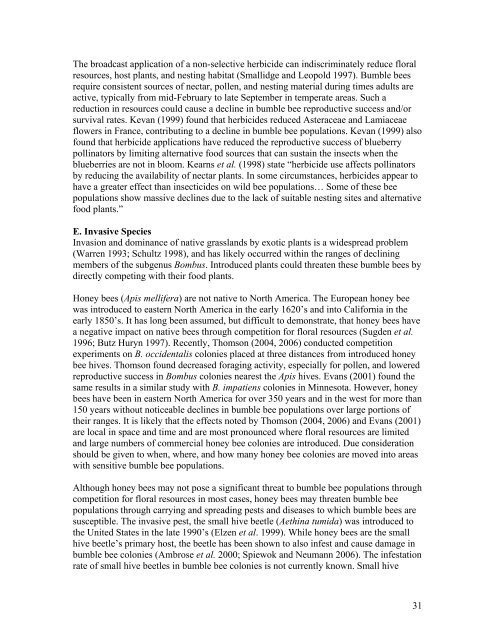Status Review of Three Formerly Common Species of Bumble Bee ...
Status Review of Three Formerly Common Species of Bumble Bee ...
Status Review of Three Formerly Common Species of Bumble Bee ...
Create successful ePaper yourself
Turn your PDF publications into a flip-book with our unique Google optimized e-Paper software.
The broadcast application <strong>of</strong> a non-selective herbicide can indiscriminately reduce floralresources, host plants, and nesting habitat (Smallidge and Leopold 1997). <strong>Bumble</strong> beesrequire consistent sources <strong>of</strong> nectar, pollen, and nesting material during times adults areactive, typically from mid-February to late September in temperate areas. Such areduction in resources could cause a decline in bumble bee reproductive success and/orsurvival rates. Kevan (1999) found that herbicides reduced Asteraceae and Lamiaceaeflowers in France, contributing to a decline in bumble bee populations. Kevan (1999) als<strong>of</strong>ound that herbicide applications have reduced the reproductive success <strong>of</strong> blueberrypollinators by limiting alternative food sources that can sustain the insects when theblueberries are not in bloom. Kearns et al. (1998) state “herbicide use affects pollinatorsby reducing the availability <strong>of</strong> nectar plants. In some circumstances, herbicides appear tohave a greater effect than insecticides on wild bee populations… Some <strong>of</strong> these beepopulations show massive declines due to the lack <strong>of</strong> suitable nesting sites and alternativefood plants.”E. Invasive <strong>Species</strong>Invasion and dominance <strong>of</strong> native grasslands by exotic plants is a widespread problem(Warren 1993; Schultz 1998), and has likely occurred within the ranges <strong>of</strong> decliningmembers <strong>of</strong> the subgenus Bombus. Introduced plants could threaten these bumble bees bydirectly competing with their food plants.Honey bees (Apis mellifera) are not native to North America. The European honey beewas introduced to eastern North America in the early 1620’s and into California in theearly 1850’s. It has long been assumed, but difficult to demonstrate, that honey bees havea negative impact on native bees through competition for floral resources (Sugden et al.1996; Butz Huryn 1997). Recently, Thomson (2004, 2006) conducted competitionexperiments on B. occidentalis colonies placed at three distances from introduced honeybee hives. Thomson found decreased foraging activity, especially for pollen, and loweredreproductive success in Bombus colonies nearest the Apis hives. Evans (2001) found thesame results in a similar study with B. impatiens colonies in Minnesota. However, honeybees have been in eastern North America for over 350 years and in the west for more than150 years without noticeable declines in bumble bee populations over large portions <strong>of</strong>their ranges. It is likely that the effects noted by Thomson (2004, 2006) and Evans (2001)are local in space and time and are most pronounced where floral resources are limitedand large numbers <strong>of</strong> commercial honey bee colonies are introduced. Due considerationshould be given to when, where, and how many honey bee colonies are moved into areaswith sensitive bumble bee populations.Although honey bees may not pose a significant threat to bumble bee populations throughcompetition for floral resources in most cases, honey bees may threaten bumble beepopulations through carrying and spreading pests and diseases to which bumble bees aresusceptible. The invasive pest, the small hive beetle (Aethina tumida) was introduced tothe United States in the late 1990’s (Elzen et al. 1999). While honey bees are the smallhive beetle’s primary host, the beetle has been shown to also infest and cause damage inbumble bee colonies (Ambrose et al. 2000; Spiewok and Neumann 2006). The infestationrate <strong>of</strong> small hive beetles in bumble bee colonies is not currently known. Small hive31
















